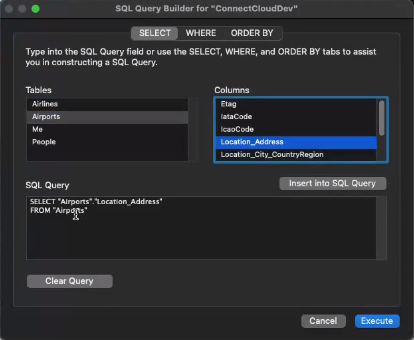Discover how a bimodal integration strategy can address the major data management challenges facing your organization today.
Get the Report →Connect to Smartsheet Data from Filemaker Pro (Mac)
Use CData Connect Cloud to connect to and query live Smartsheet data from Filemaker Pro on Mac.
FileMaker Pro is a cross-platform relational database application that allows users to visually modify a database. When paired with CData Connect Cloud, FileMaker Pro gets access to live Smartsheet data. This article demonstrates how to connect to Smartsheet using Connect Cloud and query Smartsheet data in FileMaker Pro.
CData Connect Cloud provides a pure SQL Server interface for Smartsheet, allowing you to query data from Smartsheet without replicating the data to a natively supported database. Using optimized data processing out of the box, CData Connect Cloud pushes all supported SQL operations (filters, JOINs, etc.) directly to Smartsheet, leveraging server-side processing to return the requested Smartsheet data quickly.
About Smartsheet Data Integration
CData provides the easiest way to access and integrate live data from Smartsheet. Customers use CData connectivity to:
- Read and write attachments, columns, comments and discussions.
- View the data in individuals cells, report on cell history, and more.
- Perform Smartsheet-specific actions like deleting or downloading attachments, creating, copying, deleting, or moving sheets, and moving or copying rows to another sheet.
Users frequently integrate Smartsheet with analytics tools such as Tableau, Crystal Reports, and Excel. Others leverage our tools to replicate Smartsheet data to databases or data warehouses.
Getting Started
Configure Smartsheet Connectivity for FileMaker Pro
Connectivity to Smartsheet from FileMaker Pro is made possible through CData Connect Cloud. To work with Smartsheet data from FileMaker Pro, we start by creating and configuring a Smartsheet connection.
- Log into Connect Cloud, click Connections and click Add Connection
- Select "Smartsheet" from the Add Connection panel
-
Enter the necessary authentication properties to connect to Smartsheet.
Smartsheet uses the OAuth authentication standard. To authenticate using OAuth, you will need to register an app to obtain the OAuthClientId, OAuthClientSecret, and CallbackURL connection properties.
However, for testing purposes you can instead use the Personal Access Token you get when you create an application; set this to the OAuthAccessToken connection property.
![Configuring a connection (Salesforce is shown)]()
- Click Create & Test
-
Navigate to the Permissions tab in the Add Smartsheet Connection page and update the User-based permissions.
![Updating permissions]()


Add a Personal Access Token
If you are connecting from a service, application, platform, or framework that does not support OAuth authentication, you can create a Personal Access Token (PAT) to use for authentication. Best practices would dictate that you create a separate PAT for each service, to maintain granularity of access.
- Click on your username at the top right of the Connect Cloud app and click User Profile.
- On the User Profile page, scroll down to the Personal Access Tokens section and click Create PAT.
- Give your PAT a name and click Create.
- The personal access token is only visible at creation, so be sure to copy it and store it securely for future use.

Connect to Smartsheet from FileMaker Pro using Connect Cloud
To establish a connection from FileMaker Pro to the CData Connect Cloud Virtual SQL Server API, follow these steps.
Configure the ODBC Connection to CData Connect Cloud
- Download and install the Actual ODBC Driver for SQL Server (actualtech.com)
- Configure a DSN for the Actual ODBC driver by setting the following properties:
- URL: tds.cdata.com
- Port: Change the port from 1433 to 14333
- Username: Your Connect Cloud email address
- Password: the PAT you created earlier
Query Smartsheet from FileMaker Pro
- In the SQL Query Builder "SELECT" tab, select the columns to include as part of the query.
![Configuring the query by selecting columns.]()
- Open the "WHERE" tab of the SQL Query Builder and select "Show only selected columns."
- In "Table.Column,"" select a table and a column name.
- Set the "Operator" to =.
- Select "Column," and then select the same table and column name as "Table.Column."
- Click "Insert into SQL Query."
![Configuring the query by setting the WHERE clause.]()
- If no other modifications to the SQL query are required, click "Execute."
Get CData Connect Cloud
To get live data access to 100+ SaaS, Big Data, and NoSQL sources directly from your SQL Server database, try CData Connect Cloud today!









